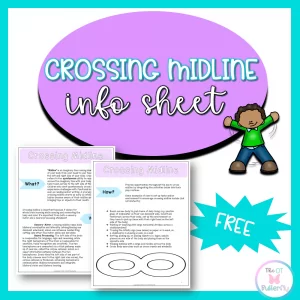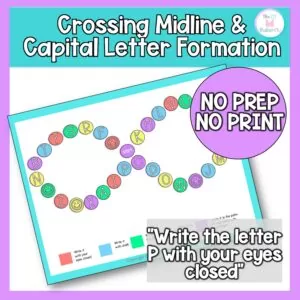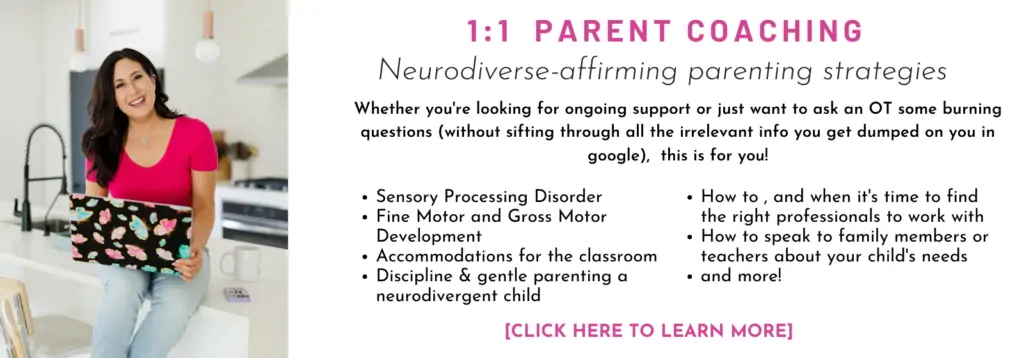Get your FREE sensory profiles cheat sheet >>click here<<
Everything You Need to Know About Crossing Midline
Is it just me, or do OTs LOVE that buzz phrase “crossing midline”? It feels like a Jeopardy answer someone would call out because they have a 50/50 shot at guessing it correctly. “What is crossing midline?”
Well, speaking as a pediatric OT, I observe/note/discuss/preach about crossing midline on a daily basis. I squeal like a little girl on Christmas morning when a new crossing midline activity comes up at the clinic. It’s so fun seeing all the creative, simple ways to incorporate crossing midline into daily activities, both in the clinic and at home.
In this article, we’ll discuss what crossing midline is, how it develops, and why it’s important.
Side note: if you’re looking for a quick cheat sheet to hand out or to keep on file, download my free crossing midline cheat sheet handout

What is crossing midline and how does it develop?
The midline is just the center of your body that discriminates the left side of your body from your right side. Crossing midline is influenced by the following developmental milestones/skills:
- If you’re a parent, you know that one of those first voluntary skills (i.e. NOT a reflex) is when babies can bring objects/toys/their cute little sweaty chubby hands to their mouth or in front of their face to explore. At this moment, the midline has been discovered and is open for business.
- After midline has been established, baby will start grabbing and grasping more objects voluntarily. Eventually, he will begin transferring objects between hands, and eventually begin using both hands at once for different functions (bilateral integration)
- Research shows (Liederman 1983) that by around 20 weeks, if you hold a toy at around shoulder level diagonal from their hand, they should be able to reach across (contralateral reaching) their body for the toy, aka crossing midline.
- Tummy time builds core stability and trunk control, which lay the groundwork for a strong posture so baby can sit up and explore the world from a different view. When baby sits up with strong postural control, he can now lean over and reach further in the environment and continue to learn through exploration.
- Sitting up and building further core and trunk strength lead to the other major milestone of infancy: crawling. Crawling is a major milestone that is so important for refining bilateral coordination, and is also a very rich sensory integrative experience (provides tactile input and proprioceptive input). With these advanced gross motor skills, babies are being exposed to activities that offer trunk rotation, which is necessary for reaching across the body and setting up for crossing midline.
- Research shows that children as young as 2 have shown spontaneous ability to cross midline at a table, and By 3-4 years old, bilateral coordination, trunk rotation and crossing midline occur more naturally and are beginning to be refined. Between the ages of 4 to 9, crossing midline has been shown to progressively increase in children (Cermak 1980)
Why is crossing midline important?
Crossing midline influences everything, from gross and fine motor skills, to higher level academic skills such as reading.
Crossing midline strengthens the neural connection between the left and right hemispheres of your brain (aka bilateral integration).
We know that the left brain processes things like language and logic while the right brain processes things like emotions, and creativity like music and art.
The whole brain functions better as a team by strengthening neural connections between the left and right hemispheres. For example, you need a whole brain, bilateral integrative connection to verbally (left brain) express your feelings (right brain) instead of just letting your emotions run wild. Hello, EMOTIONAL REGULATION!

How can I tell if my child is avoiding midline crossing?
Crossing midline is fairly simple to notice once you know what to look for. Here are 5 common signs that I notice if a child is avoiding crossing midline:
- Turning a paper 90 degrees so instead of writing/coloring horizontally (across midline) they are writing/coloring vertically (up and down)
- Continuously shifting their body in their seat to the left or right of the paper. No matter how many times you remind them to sit in the middle or to move their paper to the middle, it somehow always ends up on their dominant writing side, shifted away from midline.
- Difficulty tracking moving objects across a horizontal plane, even if they are slow- like following a balloon. Or reading across a page.
- Continuously switching objects between hands. For example, if they are right handed, rather than picking up a puzzle piece on their left side or even diagonal from them, they will pick it up with their closest hand (left) then transfer it to their right hand to be placed on the board.
- Having an immature throwing motor pattern. For example, an age appropriate overhand throw involves their arm moving up and back then throwing across their body while rotating their trunk and stepping with their opposite leg. A kiddo who throws with their arm without moving their arm back and without taking a step with their trunk stationary is a red flag for not crossing midline
If you notice any of these signs, your child may be avoiding crossing midline. The good news is, crossing midline is really easy and simple to incorporate into your daily lives and activities. To start, check out these 3 easy ways to encourage crossing midline everyday.
Check out some of my favorite ones here on my crossing midline pinterest board.

Check out these other helpful resources:
- my free crossing midline cheat sheet handout
- Crossing midline printable game for fine motor and gross motor skills
- FREE lazy 8 crossing midline game to practice capital letters










Hi,
I was looking for some resources on midline crossing and came across this. I think when talking about turning the paper to write you mean 90 degrees, as 180 degrees would mean upside down.
Otherwise a good resource to share with parents. Thanks
OMG thank you for bringing this to my attention! After all these years the post has been up 🙂 Thanks! I must have been thinking of a protractor in my mind.